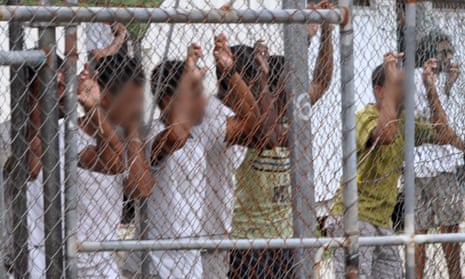After nine years, having borne witness to an immeasurable toll on human life, having poured hundreds of millions of dollars into a failing system, and after repeated international condemnation, Australia has belatedly accepted New Zealand’s resolute offer – an almost nagging entreaty – to resettle 150 refugees from Australia’s punitive offshore processing system, every year, for three years.
The offer has been on the table since 2013 – politely but persistently put by three New Zealand prime ministers to five Australian ones.
For years Australia maintained that refugees held by Australia on offshore Pacific islands could never be resettled in New Zealand. New Zealand was a “pull factor”, Peter Dutton said. “It could risk this thing opening up again,” according to Scott Morrison. It was argued that New Zealand was a “back door” to entry to Australia.
It was always a specious argument: Australia regularly prevents New Zealanders it doesn’t want from entering Australia.
If the Covid pandemic and the Novak Djokovic spectacle proved anything, it was that Australia could, and would, stop people it didn’t want at its borders, even its own citizens.
Over years, as offshore processing ground on, and the people held within it ground down, the offer was repeatedly put … and rebuffed.
Deals, Australia said, were being sought with other “third countries” to resettle refugees: the champagne-spilling catastrophe of Cambodia; the slow, unpredictable US resettlement deal.
A lucky few found ways out. Behrouz Boochani got a visa to New Zealand for a writers’ festival. Javiet Ealom escaped Manus. Others found sponsors in Europe. Australian people raised more than $4m to sponsor people held by Australia’s offshore system to resettle in Canada.
And now, it seems, New Zealand is OK. The deal announced on Thursday will see New Zealand take 150 refugees from Australia’s offshore cohort for each of the next three years. That 450 will not clear the number of people still held within Australia’s system. There are a little over 100 people currently on Nauru, who will be prioritised for this deal.
Fifty-one eligible refugees are in detention in Australia, and just over 1,100 are in the Australian community – but, the government says, with no opportunity to stay here permanently. Those people are also eligible to apply for New Zealand resettlement.
The Guardian understands there are 105 refugees and asylum seekers held on Papua New Guinea. While they are excluded from the Australia-New Zealand deal, New Zealand and Papua New Guinea have made it clear that, through the UN’s refugee agency, they will negotiate – without Australia – for the potential resettlement of refugees from Port Moresby to New Zealand. The UNHCR deal – promoted by the Australian government as “demonstration work on this is currently under way” – explicitly says there will be a separate stream for those currently in limbo in PNG.
But the architecture of offshore detention remains. “Australia’s strong border protection policies have not changed,” the home affairs minister, Karen Andrews, said on Thursday. “People who come to Australia … by boat will never be allowed to settle here.” Australia has signed an agreement with Nauru for an “enduring” offshore processing regime in that country.
Offshore processing’s great political potency was its promotion by successive governments as having successfully “stopped the boats”.
It did not do this.
In the first full year after offshore processing was reintroduced, government figures show more people arrived in Australia by boat seeking asylum than at any other time in history or since (overwhelming within three months, in fact, the capacity of the offshore detention centres Australia had built).
It was physically intercepting boats, turning their desperate passengers back at sea – often returning them to harm without proper consideration of their claim for asylum – that was the key driver in stopping the boats. No new asylum seeker or refugee has been sent to offshore processing since 2014.
But the adamantine adherence to offshore detention, in spite of all the evidence of the damage it was doing, has weakened Australia internationally, damaged its reputation and influence.
Australia has been castigated at international forums for its abuses of human rights: efforts to hold other countries to account have been met with admonishments to worry about our own backyard.
Offshore processing has also warped Australia’s relationships with the two countries browbeaten into accepting refugees from Australia. Australia’s self-image is firmly rooted in its recent history as a former British colony, but it was a coloniser too. Its two former colonies are no coincidence: PNG and Nauru.
Australia’s opposition to New Zealand’s longstanding offer has softened incrementally. Over recent months, the deal was in discussion, then being negotiated, then imminent.
The machinations, like so much of Australia’s asylum policy, have been opaque, sclerotic and undertaken with almost no consideration for those most affected by them: those held on offshore islands, counting off not in days or months the time spent in the damaging uncertainty, but years.
There were a number of factors driving the current government’s change of position.
Behind the scenes, there was lobbying from moderate Liberal party members – with an eye on the upcoming election and threatened by well-funded progressive independents certainly – but also from a conviction that the policy could no longer be rationally argued to serve any purpose, was callously cruel and deliberately punitive.
The US refugee swap had essentially run its course, having taken more than 1,200 people from Australia’s detention system for new lives there.
The financial cost became unjustifiable. Nauru, acutely, became obscenely expensive. On the government’s own figures, Australian taxpayers were paying more than $4.3m a year for every single refugee held on the island – nearly $12,000 every day for each person detained.
And public pressure remained steadfast. While asylum faded as a frontline political issue, advocacy groups, human rights organisations and refugees who’d found their way out of the regime themselves kept quietly insisting upon meetings with ministers, kept loudly taking to the streets, kept camping out in MPs’ offices.
There are some sent to Australia’s offshore detention regimes on Nauru and PNG for whom this deal means nothing: it is all too late.
Reza Berati was murdered by the men paid to protect him; Hamid Kehazaei died from reprehensible medical neglect; Omid Masoumali despaired to the point of setting himself alight publicly in protest.
Children were beaten and sexually abused in the Australian-run camps on Nauru – the regime’s own reports bear testament to it. Scores of others suffered irreparable mental harm.
All of that need not have happened. All of that happened over the past nine years.

